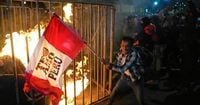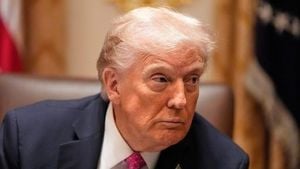In the heart of Lima, Peru’s capital, thousands of young protesters surged through the streets in mid-October 2025, their voices echoing a chorus of frustration that’s been building for years. The demonstrations, led predominantly by Generation Z activists, erupted following the ousting of President Dina Boluarte and the swift appointment of José Jerí as the country’s seventh president in less than a decade. What began as a call for better pensions and wages for young people quickly morphed into a broader outcry against crime, corruption, and a political system many Peruvians see as hopelessly broken.
By the morning of October 16, the protests had turned violent. The aftermath was grim: at least one civilian dead, more than 100 injured—including 80 police officers and 10 journalists—and a nation once again reckoning with the costs of political turmoil. The death of 32-year-old hip-hop singer Eduardo Ruíz, shot during the mass demonstration, became a flashpoint, prompting Peru’s prosecutor’s office to announce a full investigation. According to AP News, the office ordered the removal of Ruíz’s body from a Lima hospital and the “collection of audiovisual and ballistic evidence in the area where the incident occurred, in the context of serious human rights violations.”
Security footage captured the tragic moment: Ruíz collapsed on a Lima street after a man, reportedly fleeing from protesters, fired a shot. Witnesses claimed the shooter was accused of being a plainclothes police officer infiltrating the demonstration. The incident stoked long-held suspicions about police tactics and fueled the anger of demonstrators already on edge from decades of political disappointment.
Peru’s Ombudsman’s Office confirmed that, in addition to Ruíz’s death, at least 24 protesters and 80 police officers were injured during the clashes. The National Association of Journalists reported that six journalists were struck by pellets and another four were assaulted by police—an alarming sign of the risks faced by those covering Peru’s ongoing unrest.
The demonstrations have been anything but isolated. As Colombia One and AP News noted, Peru’s protests are part of a global wave of youth-led activism. From Nepal to the Philippines, Indonesia to Kenya, and Morocco, young people—often waving black flags adorned with the “One Piece” anime symbol, a pirate skull with a straw hat—have been at the forefront of movements demanding change. In Latin America, Generation Z has emerged as a critical force, organizing through social media platforms like TikTok, Instagram, and X to amplify their demands and document abuses in real time.
David Tafur, a 27-year-old electrician, joined the Lima protests after learning about them on TikTok. “We’re fighting for the same thing—against the corrupt—who here are also killers,” he told AP News, referencing the deadly government crackdowns during the 2022 protests that left 50 people dead. It’s a sentiment echoed by many young Peruvians who see little difference between the country’s revolving door of leaders—all tainted, in their view, by scandal and ineffectiveness.
The current chapter in Peru’s political saga opened with the removal of Dina Boluarte, whose nearly three-year presidency was marred by allegations of corruption, political repression, and an economic downturn. Her fall was swift, but the hopes for renewal were quickly dashed when Congress appointed José Jerí, a 38-year-old former president of Congress, as interim president on October 10. Jerí’s government was immediately beset by controversy—not only over his perceived right-wing leanings but also due to his legislative record and personal history.
Protesters have demanded Jerí’s resignation and the repeal of six laws they argue benefit criminal groups. Many also called for the resignation of other lawmakers, accusing Congress of undermining efforts to tackle crime and corruption. During the October 15-16 protests, more than 20 women chanted slogans like “The rapist is Jerí” and “Jerí is a violin”—the latter a Peruvian slang term for rapist. These accusations stem from a previous investigation into Jerí for alleged rape, a case that was dismissed in August 2025, though authorities continue to investigate another man involved in the incident.
The political turbulence deepened further with Jerí’s appointment of Ernesto Álvarez as prime minister. Álvarez, a far-right former judge known for his provocative social media presence (which he scrubbed before taking office), wasted no time in dismissing the Gen Z activists. According to Colombia One, Álvarez described Generation Z as a “gang that wants to take democracy by storm” and claimed they do not represent “the youth who study and work.” He even attempted to link the protesters to the leftist Tupac Amaru Revolutionary Movement, a group once classified as a terrorist organization by the United States.
While President Jerí publicly expressed regret over Ruíz’s death—writing on social media, “I regret the death of citizen Eduardo Ruiz Sanz, 32 years old. Strength to his family at this time. May the investigations determine the facts and responsibilities objectively”—he refused to step down. “My responsibility is to maintain the stability of the country; that is my responsibility and my commitment,” Jerí told local press, as reported by AP News, after visiting Parliament to request additional powers to combat crime.
For many Peruvians, these words rang hollow. The streets saw fireworks launched at police, tear gas and rubber pellets fired in response, and a sense of déjà vu recalling the violent government crackdowns of recent years. Signs at the protests read “Protesting is a right, killing is a crime,” and one woman’s poster summed up the prevailing mood: “From a murderess to a rapist, the same filth.”
The roots of this unrest run deep. As Omar Coronel, a sociology professor at the Pontifical Catholic University of Peru, explained to AP News, “After the pension issue, other frustrations followed—linked to insecurity, the erosion of state capacity in Peru, and corruption.” For Generation Z, raised in the digital era and shaped by economic instability and a climate of distrust, protest has become a way of life, not a last resort.
Labor unionists and relatives of those killed in past protests have joined the movement, further broadening its base. The current demonstrations are the continuation of a climate of social discontent that has persisted through more than 500 anti-government rallies and 50 deaths during Boluarte’s tenure alone. Now, with another president facing mass opposition and violence erupting once again, Peru’s youth are making it clear that they will not be silenced.
As the dust settles in Lima and investigations into Ruíz’s death continue, the question remains: can Peru’s leaders break the cycle of crisis and restore faith in the country’s democracy? For the thousands of young protesters who have taken to the streets, the answer, for now, is written on their banners—and in their unwavering resolve.




